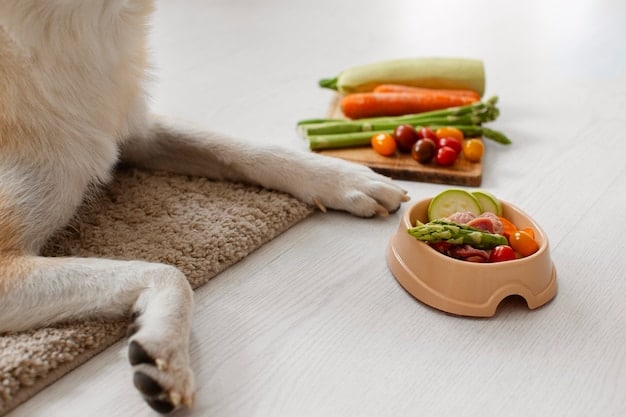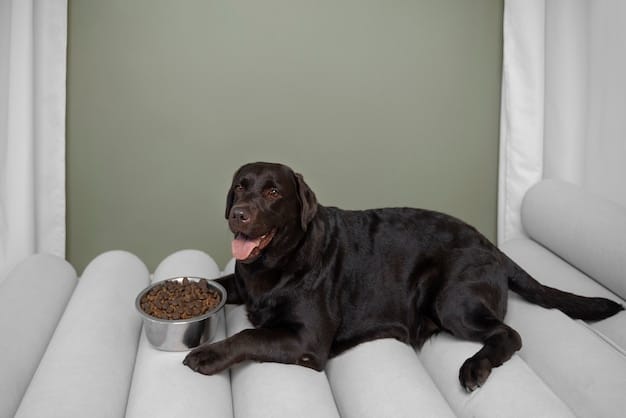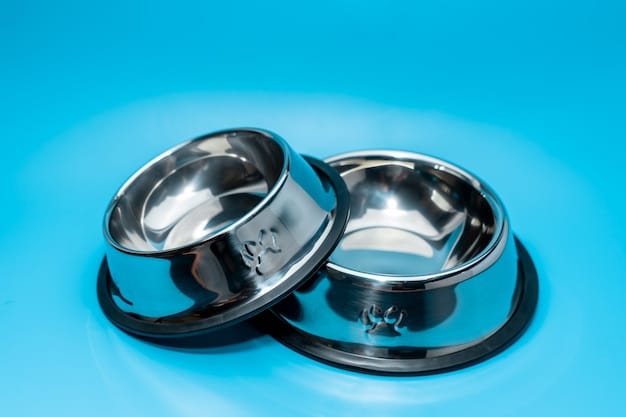Are Elevated Dog Bowls Better? A Vet-Approved Review

Anúncios
Elevated dog bowls can offer benefits like improved posture and digestion for some dogs, but they aren’t suitable for all. It’s essential to consider your dog’s breed, size, and any existing health conditions before switching to an elevated bowl.
Considering elevated dog bowls for your furry friend? While they’re touted for various health benefits, it’s crucial to understand if they’re truly the best choice for your pet. This vet-approved review dives deep into whether elevated dog bowls are better for your pet, exploring the science, benefits, and potential drawbacks, as well as spotlighting some of the top brands on the market.
Anúncios
What are Elevated Dog Bowls?
Elevated dog bowls, also known as raised feeders, are designed to lift your dog’s food and water off the floor. This positions the bowl at a more accessible height, potentially reducing strain on their neck and joints while eating or drinking. This design has gained popularity due to claims of improved digestion, posture, and overall comfort for dogs.
But are these claims valid? Let’s explore the specifics of elevated dog bowls and what makes them different.
Anúncios
The Design and Purpose
Unlike traditional bowls that sit directly on the floor, elevated bowls are typically held up by a stand or a frame. This raises the bowl to a height that is more appropriate for the dog’s size. The goal is to allow the dog to eat and drink without having to bend down as far, which can cause discomfort and strain, especially for larger breeds or dogs with mobility issues.
The ideal height for an elevated bowl varies depending on the size of your dog. A general rule of thumb is that the top of the bowl should be roughly level with the dog’s lower chest when they are standing.
Common Materials Used
Elevated dog bowls come in various materials, each with its own pros and cons. Common materials include:
- Stainless Steel: Durable, easy to clean, and resistant to bacteria. A popular choice for both the bowl itself and the stand.
- Plastic: Lightweight and often more affordable. However, plastic can be prone to scratches and may harbor bacteria more easily than stainless steel.
- Wood: Can be aesthetically pleasing and blend well with home decor. Requires more care to prevent moisture damage and bacterial growth.
- Ceramic: Heavy and stable, but can be prone to chipping or breaking.
Selecting the right material depends on your preferences, budget, and the specific needs of your dog.
In conclusion, elevated dog bowls are designed to provide a more comfortable eating experience for dogs by raising their food and water. The design and materials used play a crucial role in their effectiveness and suitability for different dogs.
Potential Benefits of Using Elevated Dog Bowls
The appeal of elevated dog bowls comes from the potential health benefits they offer. While research is still ongoing, many anecdotal reports and some studies suggest that using elevated bowls can improve a dog’s eating experience and overall health.
Whether these bowls are the right choice for your pet largely depends on its individual needs and health status.
Improved Posture and Comfort
One of the primary benefits of elevated dog bowls is improved posture. When dogs eat from a bowl on the floor, they often have to bend their necks and backs downwards, which can lead to discomfort and strain. Raising the bowl to a more appropriate height allows the dog to maintain a more natural and comfortable posture while eating.
This can be particularly beneficial for larger breeds or dogs with arthritis or other joint issues. By reducing the strain on their joints, elevated bowls can help to alleviate pain and improve their overall comfort during meal times.
Easier Swallowing and Digestion
Another claimed benefit is easier swallowing. When dogs eat from an elevated bowl, gravity can assist in moving food down the esophagus, potentially making it easier for them to swallow. Some believe this can reduce the risk of choking or regurgitation.
Moreover, some proponents suggest that elevated bowls can aid digestion by promoting a more natural flow of food through the digestive system. This might reduce occurrences of bloat, a serious condition, particularly in large breeds. But its worth to investigate this further.
Reduced Mess and Spillage
Beyond health benefits, elevated dog bowls can also help to reduce mess and spillage. When bowls are placed on the floor, dogs may be more likely to push them around or spill food and water while eating. Elevated bowls, especially those with a stable base, can help to keep everything contained and reduce the amount of cleanup required after meal times.
- Keep the area cleaner: Elevated bowls tend to keep the feeding area tidier.
- Reduce bending for cleanup: Makes it easier for owners to clean the feeding area.
- Prevent floor damage: Minimizes the risk of water damage to flooring.
Ultimately, the potential benefits of using elevated dog bowls are numerous and can significantly improve your dog’s quality of life. However, it is crucial to consider possible drawbacks and consult with a veterinarian before making a change to your dog’s feeding routine.

Potential Drawbacks and Considerations
While elevated dog bowls offer several potential benefits, they are not without their drawbacks. It’s important to consider these factors before deciding if an elevated bowl is right for your dog. Some of the concerns revolve around the breed of the dog, its individual eating habits, and the risk of certain health conditions.
A thorough understanding of these drawbacks will help you make an informed decision about elevated feeders.
Increased Risk of Bloat
One of the most significant concerns associated with elevated dog bowls is the potential increase in the risk of bloat, also known as gastric dilatation-volvulus (GDV). Bloat is a life-threatening condition in which the stomach fills with gas and can twist on itself, cutting off blood supply to vital organs.
Research published in the journal *Veterinary Surgery* indicated a correlation between the use of elevated food bowls and an increased risk of GDV, especially in large and giant breeds. The study suggested that eating from an elevated bowl could cause dogs to swallow more air, which could contribute to the development of bloat.
Not Suitable for All Dogs
Elevated dog bowls are not suitable for all dogs. Dogs with certain health conditions or those who are prone to regurgitation may not benefit from using an elevated bowl. In some cases, it can even worsen their condition. For example, dogs with megaesophagus, a condition in which the esophagus becomes enlarged and loses its ability to move food to the stomach, should not use elevated bowls.
Additionally, puppies may not benefit from elevated bowls, as they are still developing and may not have the coordination and balance needed to eat comfortably from a raised feeder.
Individual Eating Habits
A dog’s individual eating habits can also play a role in whether an elevated bowl is a good choice. Dogs who tend to gulp their food quickly may be more likely to swallow air when eating from an elevated bowl, increasing their risk of bloat. Similarly, dogs who are messy eaters may make an even bigger mess when using an elevated bowl, as food can easily fall out and onto the floor.
- Monitor eating speed: Slower eaters may benefit more.
- Observe for messiness: Some dogs may spill more food.
- Consider bowl stability: Ensure the bowl and stand are stable.
In summary, while elevated dog bowls can offer benefits, they also come with potential drawbacks. It’s vital to weigh these considerations and consult with a vet to determine if an elevated bowl is appropriate for your pet.
How to Choose the Right Elevated Dog Bowl
Choosing the right elevated dog bowl involves several considerations to ensure it meets your dog’s specific needs and promotes their health and comfort. Height is a crucial factor, but other elements like material, stability, and ease of cleaning also play significant roles.
Making an informed decision will help you select the best option for your furry friend.
Determine the Correct Height
One of the first steps in choosing an elevated dog bowl is determining the correct height. The goal is to position the bowl at a height that allows your dog to eat and drink without having to strain their neck or back. As a general guideline, measure your dog from the floor to their upper chest or shoulders. The top of the bowl should be roughly level with this measurement.
If you’re unsure, it’s better to err on the side of a slightly lower bowl, as a bowl that is too high can be uncomfortable and may increase the risk of bloat.
Consider the Material and Stability
The material of the elevated dog bowl is another important consideration. Stainless steel is a popular choice due to its durability and ease of cleaning. Plastic is more affordable but may not be as durable or hygienic. Wood and ceramic can be aesthetically pleasing but require more care to maintain.
Stability is also crucial. Look for elevated bowls with a wide, sturdy base to prevent tipping. Non-slip feet can also help to keep the bowl in place, especially for dogs who tend to be messy eaters.
Ease of Cleaning and Maintenance
Ease of cleaning is another key factor. Look for bowls that are easy to remove from the stand and dishwasher-safe for convenient cleaning. Regularly cleaning your dog’s bowl is essential to prevent the growth of bacteria and maintain good hygiene.
- Check for dishwasher-safe options: Simplifies cleaning.
- Opt for removable bowls: Easier to handle and clean.
- Consider material hygiene: Stainless steel is generally the most hygienic.
In conclusion, choosing the right elevated dog bowl involves considering height, material, stability, and ease of cleaning. By carefully evaluating these factors, you can select an elevated bowl that promotes your dog’s comfort and health.
Top Brands and Products in the Market
When it comes to elevated dog bowls, several brands offer high-quality products designed to meet the needs of different dogs. These brands focus on durability, stability, and ergonomic design to ensure your pet has a comfortable and healthy eating experience.
Exploring some of the top brands and their offerings can help you find the perfect elevated bowl for your dog.
Neater Feeder
Neater Feeder is a well-known brand that specializes in elevated dog bowls designed to contain spills and messes. Their feeders feature a two-bowl system, with a top bowl for food or water and a lower tray that catches any spills. This design helps to keep the feeding area clean and dry and prevents damage to floors.
Neater Feeders are available in various sizes to accommodate different breeds and come in both plastic and stainless steel options. They are praised for their durability and ease of cleaning.
PetFusion
PetFusion is another popular brand that offers a range of high-quality pet products, including elevated dog bowls. Their elevated feeders feature a sleek, modern design and are made from durable materials like stainless steel and bamboo. PetFusion bowls are designed to be stable and easy to clean.
Many PetFusion elevated feeders also include adjustable height options, allowing you to customize the bowl to your dog’s specific needs. This makes them a versatile choice for growing puppies or dogs with varying health conditions.
YMAX
YMAX offers stylish and functional elevated dog bowls that are designed to blend seamlessly with home decor. Their feeders feature a wooden stand with stainless steel bowls and are available in various finishes to match your existing furniture.
- Neater Feeder: Ideal for messy eaters, spill-proof design.
- PetFusion: Modern design, adjustable height options.
- YMAX: Stylish wooden stands, aesthetic appeal.
In summary, several top brands offer high-quality elevated dog bowls that cater to various needs and preferences. By exploring these brands and their products, you can find the perfect elevated bowl to suit your dog’s unique requirements.

Consulting with Your Veterinarian
Consulting with your veterinarian is a crucial step before switching to an elevated dog bowl. A vet can provide personalized advice based on your dog’s specific breed, age, health conditions, and eating habits. This ensures that the elevated bowl will be beneficial and won’t inadvertently cause harm.
Seeking professional guidance ensures you’re making the best choice for your pet’s well-being.
Assessing Your Dog’s Specific Needs
Your veterinarian can help assess your dog’s specific needs and determine if an elevated bowl is appropriate. They can evaluate any existing health conditions, such as arthritis or megaesophagus, and advise you on whether an elevated bowl could help or hinder their treatment. Additionally, they can assess your dog’s eating habits and determine if they are at risk of bloat.
This personalized assessment is essential for making the right decision and avoiding potential health risks.
Getting Recommendations for Height and Material
A veterinarian can also provide recommendations for the appropriate height and material for your dog’s elevated bowl. They can measure your dog and advise you on the ideal height to promote comfortable eating. Additionally, they can recommend specific materials that are safe and hygienic for your dog.
Their expertise ensures you select a product that is both functional and safe for your pet.
Monitoring Your Dog’s Progress
After switching to an elevated dog bowl, it’s important to monitor your dog’s progress and report any changes to your veterinarian. Keep an eye out for signs of discomfort, such as difficulty swallowing or regurgitation. Also, monitor their eating habits and note any changes in their speed or messiness.
- Discuss pre-existing conditions: Ensure the bowl won’t exacerbate health issues.
- Get height and material advice: Personalized recommendations for your dog.
- Monitor for changes: Watch for any signs of discomfort or digestive issues.
In conclusion, consulting with your veterinarian is a critical step in determining if an elevated dog bowl is right for your pet. Their expertise ensures you make an informed decision and monitor your dog’s health and well-being.
[Emoji 2 + Bloat Risk] Bloat is a serious concern; monitor for symptoms like a distended abdomen.
Symptoms can vary, so discuss these with your vet.
[Emoji 3 + Breed Matters] Large and giant breeds have different needs; consider breed-specific advice.
Each breed has specific needs; consult your vet.
FAQ About Elevated Dog Bowls
What is megaesophagus, and why does it matter in relation to elevated dog bowls?
Megaesophagus is a condition where a dog’s esophagus enlarges, affecting its ability to move food. Elevated bowls can worsen this by increasing regurgitation risk.
How do I clean elevated dog bowls properly?
Clean dog bowls regularly with soap and water. For stainless steel, ensure you’re using non-abrasive cleaners to avoid scratches.
What type of dogs benefit most from elevated bowls?
Larger breeds and senior dogs with arthritis often benefit most. Elevated bowls reduce strain on their joints and necks.
Can puppies use elevated dog bowls?
It’s generally not recommended. Puppies are still developing, and elevated bowls may not be ergonomically suitable.
Are there any downsides to using plastic bowls?
Yes, plastic bowls can harbor bacteria more easily and are less durable. Stainless steel or ceramic are often better choices.
Conclusion
In conclusion, while elevated dog bowls can offer benefits like improved posture and digestion for some dogs, they are not a one-size-fits-all solution. It’s crucial to consider potential drawbacks, such as an increased risk of bloat, and to consult with your veterinarian to determine if an elevated bowl is the right choice for your pet’s specific needs. By carefully weighing the pros and cons, you can make an informed decision that prioritizes your dog’s health and well-being.
Read more content






